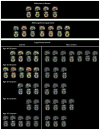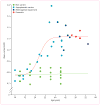Florbetapir PET analysis of amyloid-β deposition in the presenilin 1 E280A autosomal dominant Alzheimer's disease kindred: a cross-sectional study
- PMID: 23137949
- PMCID: PMC3515078
- DOI: 10.1016/S1474-4422(12)70227-2
Florbetapir PET analysis of amyloid-β deposition in the presenilin 1 E280A autosomal dominant Alzheimer's disease kindred: a cross-sectional study
Abstract
Background: Fibrillar amyloid-β (Aβ) is thought to begin accumulating in the brain many years before the onset of clinical impairment in patients with Alzheimer's disease. By assessing the accumulation of Aβ in people at risk of genetic forms of Alzheimer's disease, we can identify how early preclinical changes start in individuals certain to develop dementia later in life. We sought to characterise the age-related accumulation of Aβ deposition in presenilin 1 (PSEN1) E280A mutation carriers across the spectrum of preclinical disease.
Methods: Between Aug 1 and Dec 6, 2011, members of the familial Alzheimer's disease Colombian kindred aged 18-60 years were recruited from the Alzheimer's Prevention Initiative's registry at the University of Antioquia, Medellín, Colombia. Cross-sectional assessment using florbetapir PET was done in symptomatic mutation carriers with mild cognitive impairment or mild dementia, asymptomatic carriers, and asymptomatic non-carriers. These assessments were done at the Banner Alzheimer's Institute in Phoenix, AZ, USA. A cortical grey matter mask consisting of six predefined regions.was used to measure mean cortical florbetapir PET binding. Cortical-to-pontine standard-uptake value ratios were used to characterise the cross-sectional accumulation of fibrillar Aβ deposition in carriers and non-carriers with regression analysis and to estimate the trajectories of fibrillar Aβ deposition.
Findings: We enrolled a cohort of 11 symptomatic individuals, 19 presymptomatic mutation carriers, and 20 asymptomatic non-carriers, ranging in age from 20 to 56 years. There was greater florbetapir binding in asymptomatic PSEN1 E280A mutation carriers than in age matched non-carriers. Fibrillar Aβ began to accumulate in PSEN 1E280A mutation carriers at a mean age of 28·2 years (95% CI 27·3-33·4), about 16 years and 21 years before the predicted median ages at mild cognitive impairment and dementia onset, respectively. (18)F florbetapir binding rose steeply over the next 9·4 years and plateaued at a mean age of 37·6 years (95% CI 35·3-40·2), about 6 and 11 years before the expected respective median ages at mild cognitive impairment and dementia onset. Prominent florbetapir binding was seen in the anterior and posterior cingulate, precuneus, and parietotemporal and frontal grey matter, as well as in the basal ganglia. Binding in the basal ganglia was not seen earlier or more prominently than in other regions.
Interpretation: These findings contribute to the understanding of preclinical familial Alzheimer's disease and help set the stage for assessment of amyloid-modifying treatments in the prevention of familial Alzheimer's disease.
Funding: Avid Radiopharmaceuticals, Banner Alzheimer's Foundation, Nomis Foundation, Anonymous Foundation, Forget Me Not Initiative, Colciencias, National Institute on Aging, and the State of Arizona.
Copyright © 2012 Elsevier Ltd. All rights reserved.
Conflict of interest statement
ASF served as a consultant to Eli Lilly and Avid Radiopharmaceuticals and received grant funding from Avid Radiopharmaceuticals. The Banner Alzheimer’s Foundation has received compensation for undertaking educational programs for Avid Radiopharmaceuticals and Eli Lilly staff, which ASF contributed time towards. KSK serves as a scientific adviser to Amgen, Genentech, iPierian, and Noscira; serves on the board of Minerva Biotechnologies; and has had research contracts with the NIA and the California Institute for Regenerative Medicine. PNT has received consulting fees from Abbott Laboratories, AC Immune, Adamas, Allergan, Avanir, Boehringer-Ingelheim, Chase Pharmaceuticals, Chiesi, Eisai, Elan, Medavante, Merz, Neuroptix, Novartis, Otsuka, Sanofi-Aventis, Schering-Plough, and Worldwide Clinical Trials; consulting fees and research support from AstraZeneca, Avid Radiopharmaceuticals, Bristol-Myers Squibb, Genentech, GlaxoSmithKline, Janssen, Eli Lilly, Medivation, Merck and Company, Pfizer, Roche, Toyama, and Wyeth Laboratories; research support from Baxter Healthcare, Functional Neuromodulation, GE Healthcare, and Targacept; and other research support from NIA, National Institute of Mental Health, Alzheimer’s Association, and Arizona Department of Health Services. PNT also has stock options in Medavante and Adamas and holds a patent for biomarkers of Alzheimer’s disease. EMR has received research funding from Avid Radiopharmaceuticals and holds a paid consultation role for Eli Lilly. KC, YTQ, LJJ, MGG, CML, JBSL, NA, AR, PT, WL, HM, LL, SM, NA-B, MG, GG, RAR, MJH, and FL declare that they have no conflicts of interest.
Figures




Comment in
-
Tracking brain amyloid-β in presymptomatic Alzheimer's disease.Lancet Neurol. 2012 Dec;11(12):1018-20. doi: 10.1016/S1474-4422(12)70255-7. Epub 2012 Nov 6. Lancet Neurol. 2012. PMID: 23137951 No abstract available.
-
Alzheimer disease: New insights into preclinical Alzheimer disease.Nat Rev Neurol. 2013 Jan;9(1):4. doi: 10.1038/nrneurol.2012.243. Epub 2012 Nov 20. Nat Rev Neurol. 2013. PMID: 23165336 No abstract available.
References
-
- Braak H, Braak E. Staging of Alzheimer-related cortical destruction. Int Psychogeriatr. 1997;9 (suppl 1):257–61. - PubMed
-
- Morris JC, Price AL. Pathologic correlates of nondemented aging, mild cognitive impairment, and early-stage Alzheimer’s disease. J Mol Neurosci. 2001;17:101–18. - PubMed
-
- Rowe CC, Ellis KA, Rimajova M, et al. Amyloid imaging results from the Australian Imaging, Biomarkers and Lifestyle (AIBL) study of aging. Neurobiol Aging. 2010;31:1275–83. - PubMed
-
- Fleisher AS, Chen K, Liu X, et al. Using positron emission tomography and florbetapir F18 to image cortical amyloid in patients with mild cognitive impairment or dementia due to Alzheimer disease. Arch Neurol. 2011;68:1404–11. - PubMed
Publication types
MeSH terms
Substances
Grants and funding
LinkOut - more resources
Full Text Sources
Medical
Research Materials

